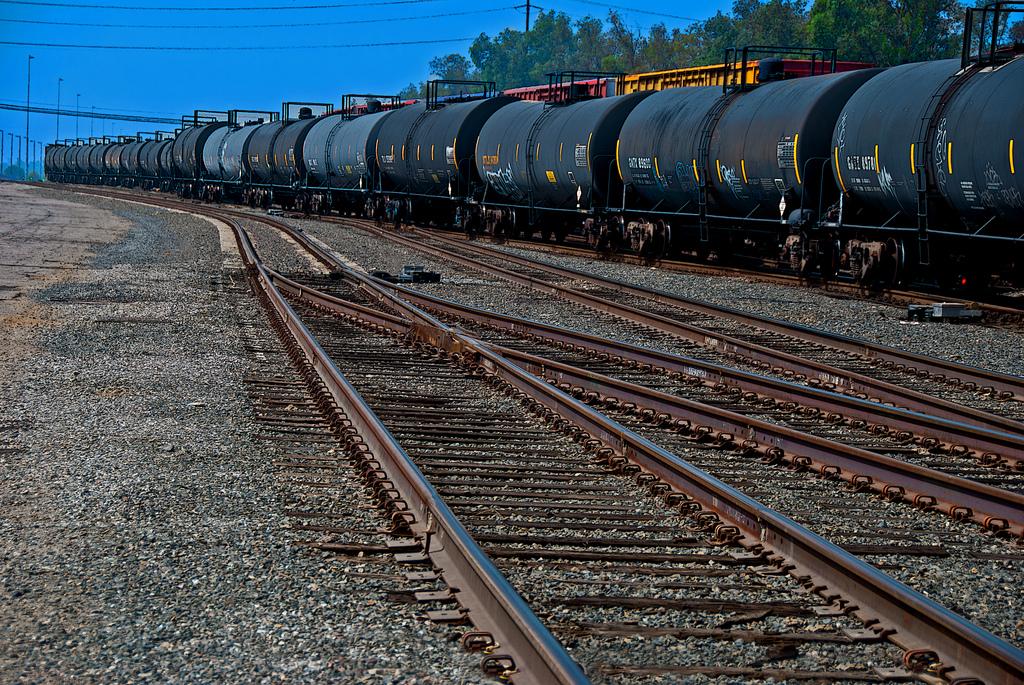
More rail cars carrying oil are moving through the Northwest. A small percentage are inspected, and very few violations are found. Legislators are more concerned about lax requirements for the tanker car specifications.
Russ Allison Loar/Flickr
If trains are hauling flammable crude oil through your town, you probably want those trains inspected. So when we were researching yesterday's piece covering what state agencies know about oil shipments on the Northwest's rail lines, the question naturally came up:
In a given year, how many of those trains are inspected as they move through Oregon and Washington?
As it turns out, only a small percentage. But that might not be the real issue in ensuring safety of rail shipments of oil.
John Johnson, rail safety manager for the Oregon Department of Transportation, estimated that his inspectors see roughly 1 percent of all trains that move through the state, regardless of what they’re carrying. For trains carrying hazardous material -- crude oil, for instance -- they make an effort to inspect more. He said they might reach somewhere up to 10 percent of those trains, but he stressed that was an estimate, not a hard number.
“We have upped our inspections and so the inspectors do look at more of the coal and oil trains than we used to when they were just kind of a general occurrence that happened occasionally,” Johnson said. “Since they've upped their number of trains through Oregon, we do do more inspections on those trains.”
Johnson shared a breakdown of what his inspectors found last year:
- Total train units inspected: 21,294
- Out of compliance: 954
- Rate of noncompliance: .04
According to Johnson, non-complying conditions include "anything from improperly filling out a repair record, failure to document a railroad inspection, a safety appliance being bent, to a defect in the brake or suspension system of a car or locomotive.
- Total track units inspected: 6,123
- Out of compliance: 2753
- Rate of noncompliance: .45
Problems found on tracks include "anything from a loose bolt, recording keeping defects, vegetation overgrowth, fouled ballast subgrade causing ride quality issues, to a broken rail."
So Oregon DOT inspectors find a fair number of problems with track but a small rate of problems on cars they inspect (which is already a small percentage of all rail cars).
In Washington, the Utilities and Transportation Commission shared its inspection reports and they, too, show that violations are rare. But the UTC also sees only a small portion of what moves through.
“Our focus is really limited,” UTC rail safety manager Kathy Hunter said. “There's been a lot of deregulation over the years in the railroad industry, so our primary focus is around crossings.”
That's in addition to what inspections the Federal Railroad Administration performs. Railroads, spanning multiple states, fall under federal jurisdiction. State agencies like ODOT or UTC can perform inspections to make sure cars and tracks are in compliance, but no one at the state level can determine what exactly is compliance.
In terms of ensuring the safety of oil by rail, the potential for danger seem to be more tied to what acceptable standards are rather than whether railroads meet those standards. For instance, the most common tanker car, the DOT-111 (often described as a black soda can on wheels), has been proven in studies to be flawed and easily punctured, and yet still meets federal standards.
That’s why safety advocates, legislators and even industry groups have called for a closer look at safety regulations, to make sure they keep up with the rapid increase in shipments.
Then, when local inspectors see a car on the rails that federal investigators knew was flawed 20 years ago, they’ll be able to do something about it. Right now, they can’t.
-- Tony Schick
